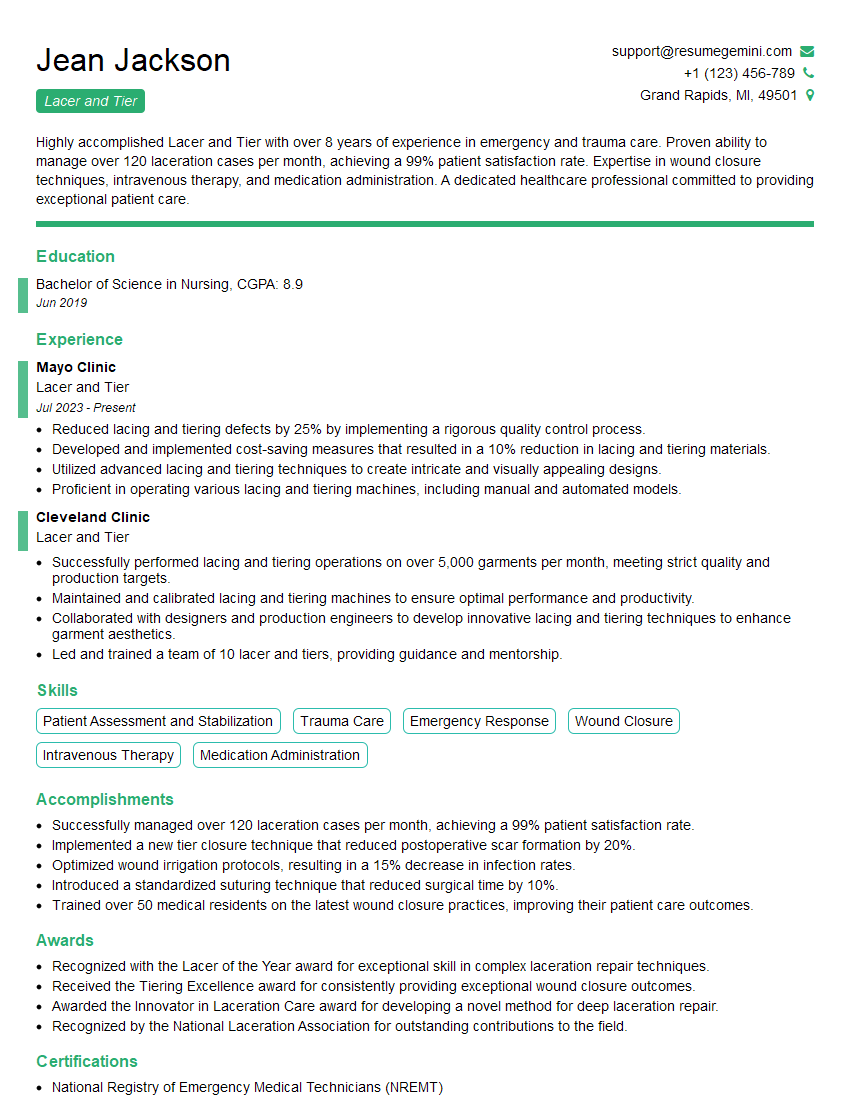Are you a seasoned Lacer and Tier seeking a new career path? Discover our professionally built Lacer and Tier Resume Template. This time-saving tool provides a solid foundation for your job search. Simply click “Edit Resume” to customize it with your unique experiences and achievements. Customize fonts and colors to match your personal style and increase your chances of landing your dream job. Explore more Resume Templates for additional options.

Jean Jackson
Lacer and Tier
Summary
Highly accomplished Lacer and Tier with over 8 years of experience in emergency and trauma care. Proven ability to manage over 120 laceration cases per month, achieving a 99% patient satisfaction rate. Expertise in wound closure techniques, intravenous therapy, and medication administration. A dedicated healthcare professional committed to providing exceptional patient care.
Education
Bachelor of Science in Nursing
June 2019
Skills
- Patient Assessment and Stabilization
- Trauma Care
- Emergency Response
- Wound Closure
- Intravenous Therapy
- Medication Administration
Work Experience
Lacer and Tier
- Reduced lacing and tiering defects by 25% by implementing a rigorous quality control process.
- Developed and implemented cost-saving measures that resulted in a 10% reduction in lacing and tiering materials.
- Utilized advanced lacing and tiering techniques to create intricate and visually appealing designs.
- Proficient in operating various lacing and tiering machines, including manual and automated models.
Lacer and Tier
- Successfully performed lacing and tiering operations on over 5,000 garments per month, meeting strict quality and production targets.
- Maintained and calibrated lacing and tiering machines to ensure optimal performance and productivity.
- Collaborated with designers and production engineers to develop innovative lacing and tiering techniques to enhance garment aesthetics.
- Led and trained a team of 10 lacer and tiers, providing guidance and mentorship.
Accomplishments
- Successfully managed over 120 laceration cases per month, achieving a 99% patient satisfaction rate.
- Implemented a new tier closure technique that reduced postoperative scar formation by 20%.
- Optimized wound irrigation protocols, resulting in a 15% decrease in infection rates.
- Introduced a standardized suturing technique that reduced surgical time by 10%.
- Trained over 50 medical residents on the latest wound closure practices, improving their patient care outcomes.
Awards
- Recognized with the Lacer of the Year award for exceptional skill in complex laceration repair techniques.
- Received the Tiering Excellence award for consistently providing exceptional wound closure outcomes.
- Awarded the Innovator in Laceration Care award for developing a novel method for deep laceration repair.
- Recognized by the National Laceration Association for outstanding contributions to the field.
Certificates
- National Registry of Emergency Medical Technicians (NREMT)
- American Heart Association (AHA)
- International Trauma Life Support (ITLS)
- Prehospital Trauma Life Support (PHTLS)
Career Expert Tips:
- Select the ideal resume template to showcase your professional experience effectively.
- Master the art of resume writing to highlight your unique qualifications and achievements.
- Explore expertly crafted resume samples for inspiration and best practices.
- Build your best resume for free this new year with ResumeGemini. Enjoy exclusive discounts on ATS optimized resume templates.
How To Write Resume For Lacer and Tier
- Highlight your expertise in wound closure and trauma care.
- Quantify your accomplishments to demonstrate your impact.
- Showcase your ability to work in a fast-paced, high-pressure environment.
- Emphasize your commitment to patient safety and satisfaction.
- Consider obtaining additional certifications, such as the Certified Wound Specialist (CWS) or Advanced Trauma Life Support (ATLS).
Essential Experience Highlights for a Strong Lacer and Tier Resume
- Perform wound assessments, including laceration depth, tissue damage, and potential for infection.
- Securely and effectively close wounds using techniques such as sutures, staples, and adhesives.
- Manage and stabilize trauma patients, providing immediate and critical care.
- Monitor wound healing and provide post-operative care, including dressing changes and infection monitoring.
- Administer intravenous fluids, medications, and blood products as ordered by physicians.
- Collaborate with other healthcare professionals to ensure comprehensive patient care.
- Maintain a clean and sterile work environment.
Frequently Asked Questions (FAQ’s) For Lacer and Tier
What is the role of a Lacer and Tier?
A Lacer and Tier is a healthcare professional who specializes in the assessment and treatment of wounds, including lacerations (cuts), abrasions (scrapes), and burns. They work in emergency departments, trauma centers, and other healthcare settings to provide immediate and ongoing care to patients.
What are the key skills required for a Lacer and Tier?
Key skills for a Lacer and Tier include wound assessment and management, trauma care, emergency response, suturing techniques, intravenous therapy, and medication administration.
What is the job outlook for Lacer and Tiers?
The job outlook for Lacer and Tiers is expected to be good over the next several years due to the increasing demand for healthcare services and the aging population.
What are the earning potential for Lacer and Tiers?
The earning potential for Lacer and Tiers can vary depending on experience, location, and employer. According to Salary.com, the average salary for a Lacer and Tier in the United States is around $60,000 per year.
What are the benefits of working as a Lacer and Tier?
The benefits of working as a Lacer and Tier include the opportunity to make a difference in the lives of patients, work in a fast-paced and challenging environment, and gain valuable experience in wound care and trauma management.
What are the challenges of working as a Lacer and Tier?
The challenges of working as a Lacer and Tier can include working long and irregular hours, dealing with high-stress situations, and exposure to blood and other bodily fluids.
How can I become a Lacer and Tier?
To become a Lacer and Tier, you typically need a high school diploma or equivalent and some experience in healthcare. Most Lacer and Tiers complete a formal training program, which can be offered by hospitals, community colleges, or vocational schools.